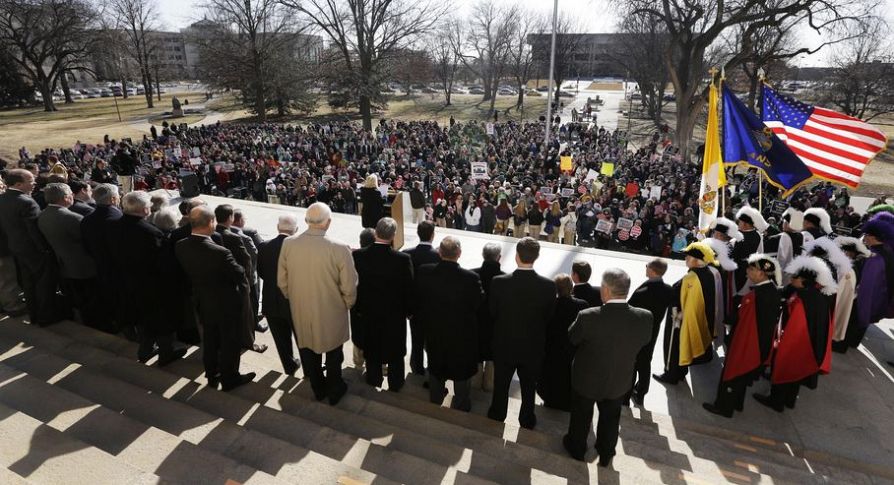Notes
On the Wrong Side of History: Further Thoughts on an Iconic Civil Rights Photograph
On Saturday morning, after digging my car out from the previous night’s snowfall, I went with my wife and sons to a large-scale estate sale held in a warehouse down in Braddock, Pennsylvania. The contents of three homes were being liquidated and had been relocated to this warehouse, then opened to the public.
The building was packed when we arrived. It was 16 degrees outside, so large torpedo heaters burning kerosene had been stationed by the doors. I could see my breath as I flipped through old 45s and sifted through bins of old toys. The accumulation and presentation of so many varied items was intriguing as a whole, but nothing much jumped out at me.
Until, that is, I made my way back to the books and magazine area. First I found a stack of old Savage Sword of Conan comic magazines that Marvel used to publish. They were moth-eaten and priced at $1 each. Not worth picking up, I decided. But then I found a giant stack of National Press Photographer magazines from the 1960s. And that’s when I came across an issue from 1964, with Bill Hudson’s infamous photograph of Walter Gadsden being attacked by a police dog in Birmingham. Alabama (pictured above):
[Hudson] took a photo on May 3, 1963, of Walter Gadsden, an African-American bystander who had been grabbed by a sunglasses-wearing police officer, while a German Shepherd lunged at his chest.The photo appeared above the fold, covering three columns in the next day’s issue ofThe New York Times, as well as in other newspapers nationwide. Author Diane McWhorter wrote in her Pulitzer Prize-winning 2001 book Carry Me Home: Birmingham, Alabama, the Climactic Battle of the Civil Rights Revolution that Hudson’s photo that day drove “international opinion to the side of the civil rights revolution.”
The caption for Hudson’s photograph, which had been included in that issue of the magazine as a finalist for some award given out by the National Press Photographer Association, doesn’t mention Gadsden by name. Instead it refers to him as a “negro” being attacked by a police dog during a “racial demonstration.” The power of the image, it seemed, was the salient point here, not the context. I ended up buying the magazine (which also featured Malcolm Browne’s image of a Vietnamese Buddhist’s monk’s self-immolation). And after I got home, I read a little deeper about the origin and context of the photograph:
The young man in the picture, Walter Gadsden, was a member of one of the families that refused to take part in the demonstrations. He was simply watching the events. Gadsden had no fear of large dogs because he owned one himself and knew how to control them. Officer Dick Middleton was the antithesis of the stereotyped policeman. Middleton, a mild-mannered man whose hobby was cooking, had a reputation of treating all citizens fairly. Officer Middleton had his German shepard, Leo, on a leash at all times.
Middleton is trying to maneuver Gadsden to a police car for refusing an order to leave the street. If you examine the picture closely, you will see that Officer Middleton is restraining Leo with his leash while he clutches Gadsden’s sweater. But Gadsden, grabbing Officer Middleton’s arm for balance, forcefully plunges his knee into Leo’s throat. An SCLC member claimed that Leo’s jaw had been broken. Another report indicated that the dog collapsed because its breath had been knocked out of it. And there were reports of other injuries to Leo that were being treated by a veterinarian. In any event, Leo left the encounter in worse shape than Walter Gadsden.
Reading images can be tricky. But here Gail Jarvis, whose text is in the preceding block quotes, offers a fairly even-handed analysis. Except it’s not entirely clear that Gadsden is kicking his knee into the police dog’s throat as she states, at least from my read of the image. If he is, it’s very likely a defensive reaction. But what’s most interesting here is perception as it pertains to the three main players in this image: Walter Gasden, Officer Dick Middleton, and police dog Leo. If Jarvis’ assessment of Officer Middleton is true, that he was indeed “the antithesis of the stereotyped policeman,” his (potentially inaccurate) portrayal in this photograph falls on the wrong side of history. Because if so, he comes across as just another hard case southern lawman hiding behind a police dog and a pair of mirrored sunglasses. And with that, all the nuances of his personality are reduced to a stereotype.
— Matthew Newton
This piece was cross-posted from writer and journalist, Matthew Newton‘s blog. You can follow it here.
(Credit: Bill Hudson’s photograph of Parker High School student Walter Gadsden being attacked by dogs was published in The New York Times on May 4, 1963)


Reactions
Comments Powered by Disqus